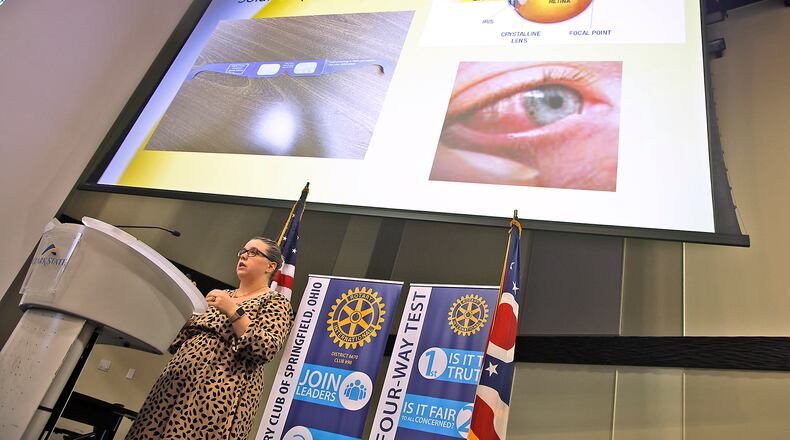The Clark County Combined Health District (CCHD) has been working with the Clark County EMA to plan for this event, for which Ohio adopted the slogan, “Come early, stay late.”
“The fact that it’s happening here in Ohio is a big deal, the fact that it’s happening here in the United States is a big deal,” Stephanie Johnson, emergency preparedness coordinator for the CCCHD, said Monday during a Springfield Rotary Club meeting.
She said the last total solar eclipse visible in Ohio was in 1806. After the April 8 one, “then the next total solar eclipse will be visible in Ohio in the year 2099. So, the next time the solar eclipse will even be in the U.S., not Ohio, will be 2044, so this is a once-in-a-lifetime event for most people.”
Johnson said there have only been 21 solar eclipses since the founding of the U.S. that have gone through the lower 48 states.
The partial eclipse will begin in Springfield at 1:54 p.m. Totality will then begin at 3:09 p.m. and end at 3:13 p.m. The partial eclipse will end at 4:25 p.m. For those watching, the CCCHD has been giving out free eclipse viewing glasses. Johnson said the health district started with 100,000 glasses and they are now down to 72,000.
In response to an audience question, she did say pet owners shouldn’t have to worry about their animals or dogs because “they’re not typically looking at the sun.”
While most of the time, viewers will need to wear the special glasses, those in the path of totality will be allowed to take them off for a few minutes, between 3:09 and 3:13 p.m., Johnson said.
“You’ll be able to see the corona, which is the rare event that’s happening,” Johnson said.
People within a 124-mile-wide band in Ohio will experience the eclipse, and areas in Ohio that are outside that path of totality will still experience it to some extent, Johnson said.
The eclipse could impact Springfield and Clark County from Thursday, April 4, through Tuesday, April 9.
Most of the county is in the path of totality, and officials expect two to four times the population of the county to be in Clark County for the eclipse. As Ohio is promoting, “Come early, stay late,” they are encouraging people to get to their location days early, which is why the impact is expected for several days.
Johnson also warned that viewers will be looking for clear skies the day of the event, so Clark County could be a last-minute location because of the weather forecast that day.
The biggest concern in Clark County is the traffic, especially since Springfield is on Interstate 70, near Interstate 75, state Route 41, state Route 4 and U.S. 68, Johnson said. Previous events elsewhere saw the traffic spread over a few days, which is why they’re expecting a longer impact time.
Besides traffic, there are concerns about cell phones and Wi-Fi that could be significantly impacted, such as texting, calls and FaceTime, mapping and other apps, and the ability to use credit cards or features like Apple Pay if systems are slow or not working. There are also concerns of people leaving as soon as the eclipse ends around 4:30 p.m., and they could overcrowd restaurants, drive-through’s and restrooms.
The CCCHD is recommending that people get gas as early as possible if you know you’re going to be in town, get cash out in case cell phones or Wi-Fi is down, and get groceries in case a shortage of certain items may happen with many people staying at campgrounds.
The eclipse is also during school dismissal times and those in Clark and Champaign counties have closed or rescheduled teacher professional development days.
Most county superintendents said they made this decision due to the expected traffic coming to the area and the potential delays. Students and staff were also provided with solar eclipse glasses.
This eclipse is also different than the partial eclipse in Ohio in 2017 because that path was only 62 to 71 miles wide and the county wasn’t in the path of totality, Johnson said. It will also pass over more populated cities: there are 31.6 million people who live in the totality path and 150 million live within 200 miles of the path.
Johnson added a lunar eclipse, when the earth gets between the sun and moon, will also happen at 3:10 a.m. on March 25.
About the Author


